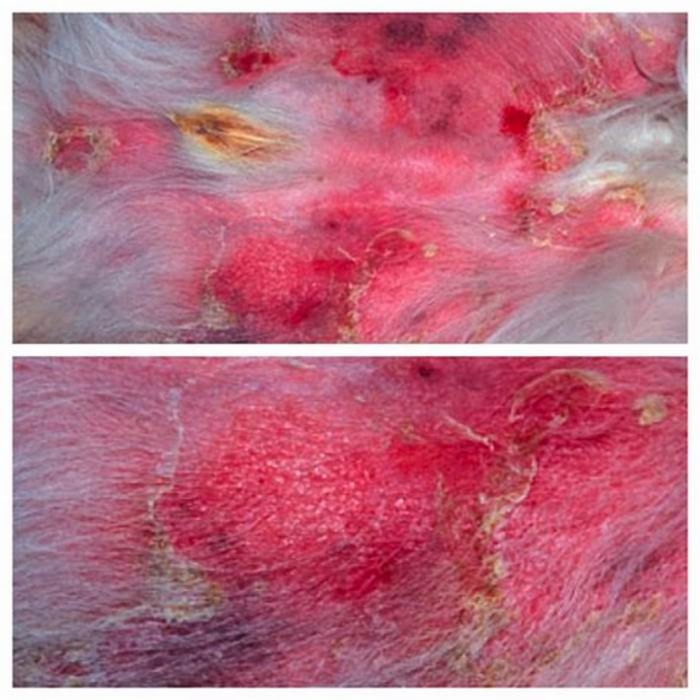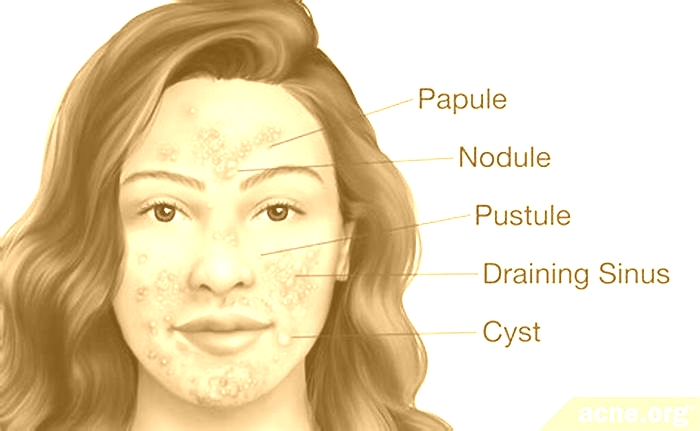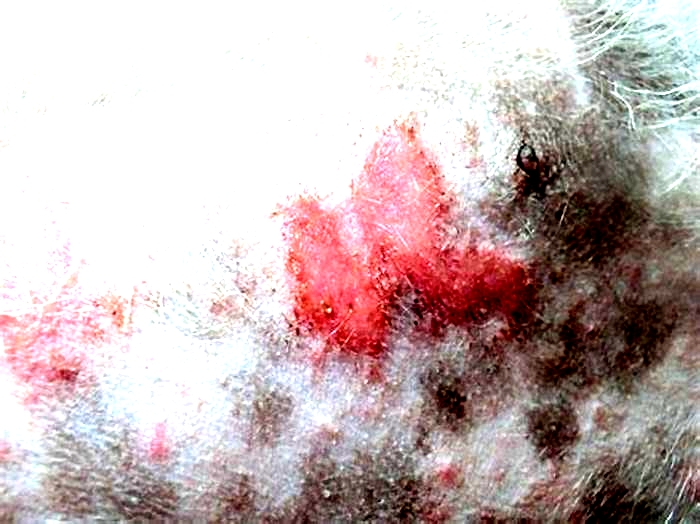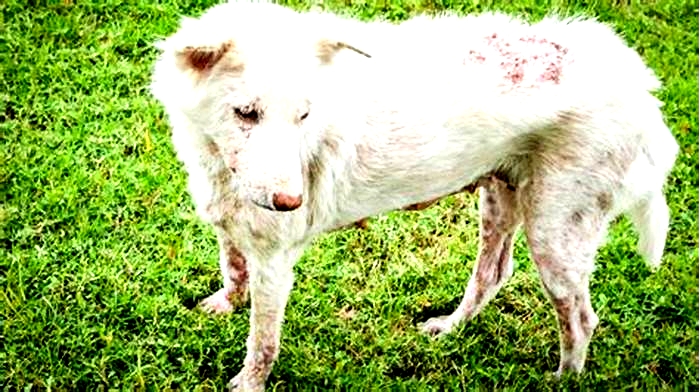How did my dog get pyoderma

Pyoderma in Dogs: What You Need to Know
If your dog is experiencing itchy skin, inflamed skin, or flaking, it can be caused by many different things. One of dogs most commonly diagnosed skin diseases is a bacterial infection known as pyoderma. While this condition might seem superficial and easy to treat, its often just the tip of the iceberg and goes below the skin.
Pyoderma in dogs typically masks another underlying condition, so its worth checking out if your dog is experiencing symptoms. Understanding canine pyoderma could help your dog receive prompt diagnosis and treatment, which can prevent recurring infections and more serious and ongoing illnesses.
What Is Pyoderma in Dogs?
Pyoderma, also known as bacterial dermatitis, is a bacterial skin disease. Dr. Amelia White, DVM, is an associate clinical professor of dermatology at the Auburn University College of Veterinary Medicine. [Its] classically caused by the bacteria Staphylococcus pseudintermedius, which is always present on the dogs skin, she says. While this bacteria is normal on the skin, infection can occur if the bacteria gets into the body.
Dr. Christine Cain, DVM, is an associate professor of dermatology at the University of Pennsylvania School of Veterinary Medicine. She says that pyoderma is almost always associated with an underlying condition. Dr. Cain notes these conditions usually compromise the skin barrier or impair the immune system.
Some of the most common conditions associated with pyoderma include:
When dogs itch or scratch their skin because its painful or uncomfortable, theyre actually creating an opening for the inflammation to progress. With a skin allergy, the barrier gets inflamed from the allergen. Now, those bacteria can get in deeper, creating infection, Dr. White explains. Typically, with this type of inflammation, the immune systems natural response would be to detect and kill the bacteria. But when the immune system is compromised because of an underlying condition, this doesnt happen, and the infection takes hold.
Some breeds are also more genetically predisposed to developing pyoderma. These include German Shepherd Dogs, Chinese Shar-Peis, and Bulldogs. Skin fold pyoderma is common in breeds with more wrinkles because the folds create a moist, warm environment that allows bacteria to flourish.
Types and Symptoms of Canine Pyoderma
If you suspect that your dog might have pyoderma or another skin condition, look out for flaky scales, lesions, and excessive scratching in your dog. All of these are classic symptoms of skin infections, but be aware that pyoderma symptoms are wide-ranging and can mimic various other conditions. Make sure to consult your vet, who can classify the pyodermas severity based on where the infection is and how deep it is.
Surface Pyoderma in Dogs
Dr. Cain explains that this refers to infection only found on the outermost layer of the skin, called the epidermis. These might be mild but itchy hot spots or skin fold infections known as intertrigo. These infections havent penetrated your dogs skin or body deeply, and it is the most easily treatable type of pyoderma.
Superficial Pyoderma in Dogs
Dr. Cain explains this is the most common type of pyoderma in dogs. The infection extends to the hair follicles and the outermost layer of skin. It is a bit deeper than surface pyoderma since it also impacts the hair cavities that your dogs coat comes out of. There are also different types of superficial pyoderma, which depend on where the pyoderma specifically extends into.
One of the most common types of superficial pyoderma is superficial bacterial folliculitis. Dogs often have red or pus-filled bumps, scabs, or circular lesions with a crust or rim of flaky skin. Impetigo in puppies is another form of superficial pyoderma.
Deep Pyoderma in Dogs
This type of pyoderma typically occurs when hair follicles from the superficial stage rupture. As a result, the infection extends past the epidermis into the dermis and into the deepest layer of skin closest to the muscle, known as the subcutis. This condition often sees firm, elevated bumps called nodules. You might also see painful lesions, known as draining tracts, leading from the nodule outwards to the skin. Acne, abscesses, and lick granulomas (infections caused when a dog repeatedly licks at an area) are a few examples of these types of lesions.
Your dog may exhibit other signs of pain or discomfort, like lethargy, loss of appetite, or shaking, especially if they have deep pyoderma or another serious underlying condition. You might also see changes in behavior, such as unusual irritability or a reluctance to exercise, play, or interact as normal.
How Do Vets Diagnose Pyoderma in Dogs?
When the pet comes in, the way I become suspicious that its a skin infection is by the lesions present, Dr. White says. However, vets typically need to do further detective work to definitively diagnose pyoderma and its underlying cause.
As well as administering a physical exam, taking a detailed patient history, and conducting a cytology test (non-invasively checking skin cells under a microscope) are key elements in the process. My cytology findings say yes, this is bacteria on the skin. But why? Dr. White says.
She explains that once the vet has identified Staphylococcus pseudintermedius as the source, they might ask questions like Is your pet itchy? A pet dealing with itchy skin may be scratching, licking, chewing, and rubbing, all activities youll want to report. The vet will also want to establish when the itchiness started.
If the pet was itchy before the skin lesions appeared, Dr. White says it moves allergies to the top of the list as the cause. If they tell me no, hes not itchy, its his appetite thats not great, or hes slowing down or sleeping a lot, thats going to tell me some significant internal disease is the likely cause. In these cases, things like hypothyroidism or Cushings disease might be possibilities, and your vet will need to run further bloodwork.
Skin scrapings and bacterial and fungal cultures may also be necessary to rule out parasitic infections.
How to Treat Pyoderma in Dogs
Treatment for the skin infection varies depending on the severity and depth of the pyoderma. Often, with surface and superficial pyoderma, we can get that to go away with topical medicated therapy, which is a lot safer for the pet and owner because were not exposing them to antibiotic use, Dr. White says.
Topical treatments include medicated shampoos or ointments, Epsom salt soaks, or antiseptic washes. Your dog may also have to tolerate an Elizabethan collar or surgical suit to prevent them from further licking or scratching the infected area. Your vet may prescribe antibiotics and some anti-itch meds for more severe infections.
But it isnt just about getting the pyoderma itself under control. Identifying and controlling the underlying cause of pyoderma is key to preventing recurrent infections, which can be associated with more chronic changes to the skin, discomfort to the patient, expense to clients, and drug-resistant organisms, Dr. Cain says.
Treatment length varies. Typically, it will last at least a few weeks, but some deep pyoderma treatments can last months. And some underlying conditions may require continual medical management.
Carefully following your vets instructions greatly increases the chance of a speedy and successful outcome. Even if your dog seems more comfortable and their skin is clearing up nicely, stopping administering the treatment too early can cause serious setbacks.
Issues With Antibiotic Resistance
Antibiotic resistance is increasingly prevalent in staphylococcal infections in dogs, Dr. Cain says. This makes treating pyoderma caused by antibiotic-resistant strains of Staphylococcus more challenging. Using antibiotics to which pyoderma is not resistant could carry more risks for the dog. Because antibiotics are less common, they are also likely to be more expensive. Plus, there are often efforts to retain these last resort antibiotics for the treatment of drug-resistant infections in humans.
Dr. Cain explains that veterinary professionals are working towards even more effective pyoderma treatments. [They] are increasingly focusing on treatment strategies for pyoderma that may minimize antibiotic resistance development, Dr. Cain says. For example, prioritizing topical antibacterial therapies for surface or superficial pyoderma as our first-line treatment strategies before reaching for an oral antibiotic if possible.
Using antibiotics judiciously is also important because, while people might not naturally have Staphylococcus pseudintermedius on or in their bodies, this bacteria can spread genetic changes to Staphylococcus aureus, which is common in humans. As a result, Staphylococcus aureus could also develop antibiotic-resistant strains.
Why Good Home Hygiene Is So Important for Dogs
Most of the time, pyoderma isnt contagious. Dogs and humans in the same household rarely pick up each others pyoderma infections. Dr. Cain says that humans typically develop infections from other species of Staphylococcus that are more adapted to humans than dogs (such as Staphylococcus aureus).
Dogs can occasionally develop infections with Staphylococcus aureus, and humans can occasionally develop infections with Staphylococcus pseudintermedius, she says. However, animals or humans with compromised immune systems are at greater risk for these infections.
Dr. Cain recommends practicing good household hygiene to minimize risks, including making sure you wash your hands diligently, keeping pet bedding and dishes clean, household cleaning and/or disinfection, covering open wounds, and not allowing your dog to lick peoples hands or faces.
Pyoderma in Dogs
What Is Pyoderma in Dogs?
Pyoderma is the medical term for a bacterial skin infection and it is one of the most common diseases in dogs. Dogs are at increased risk for pyoderma due to many features of their skin. For example, a dogs skin has a thinner outer barrier and possesses a higher pH than many other species, making it easier for normal bacteria living on the skin to overgrow and for other bacteria to invade.
Damage to the normal skin barrier also predisposes dogs to pyoderma. This is often seen with pets who scratch and lick their skin. Any area of the skin can be infected depending on the type of pyoderma affecting your dog.
Types of Pyoderma in Dogs
Surface pyodermaaffects the outer skin layer (epidermis). You may see pink, irritated skin, and hair loss. Surface pyoderma includes:
Pyotraumatic dermatitis (hot spots): This develops rapidly and is very itchy.
Intertrigo: Infection of skin folds, a common condition in short-muzzled breeds, such as English Bulldogs.
Bacterial overgrowth syndrome (BOGS): The dogs skin is greasy, itchy, and smells. It is most seen on the underside of the body.
Superficial pyoderma affects the epidermis and part of the hair follicles. You may see redness, circular crusts, bumps, and hair loss. Superficial pyoderma includes:
Impetigo (puppy pyoderma): This is an infection that is usually due to a puppys developing immune system and affects areas with little hair, like the belly.
Affected puppies are usually healthy overall and in mild cases may only need a topical treatment. Adult dogs that are immunocompromised can also develop impetigo.
Superficial bacterial folliculitis (SBF) and superficial spreading pyoderma: A dogs coat may have a moth-eaten appearance due to widespread hair loss. This happens in all breeds, but Shetland Sheepdogs, Border Collies, Australian Shepherds, and Collies may experience especially severe redness and irritation.
Mucocutaneous pyoderma: This type of pyoderma leads to the overproduction of mucus in the skin. The lips, nose, skin around the eyes, vulva, prepuce, and the area around the anus are most commonly affected. German Shepherds, Bichon Friss, and poodles may be predisposed.
Deep pyoderma affects lower skin layers (dermis, subcutis): This can occur if superficial pyoderma goes untreated or skin follicles rupture. You may see swelling, purple-looking areas, or draining tracts of infection in addition to redness, crusting, and hair loss. Deep pyoderma includes:
Furunculosis: This condition is commonly seen between a dogs toes, but it can occur elsewhere. In rare cases, a condition called post-grooming furunculosis can occur 24 to 48 hours after bathing or intense brushing, causing pain and fever.
Acne: This is more common among young dogs, and involves inflammation of hair follicles (usually around the chin and mouth) that may become infected with bacteria.
German Shepherd deep pyoderma: The outer thighs, groin, and trunk are likely to be affected.
Lick granuloma: Your dog may develop a skin lesion from licking the top surface of its lower legs. This may stem from a bacterial infection or another issue.
Callus pyoderma: This condition presents itself as dark, thickened skin over pressure points that are infected.
Symptoms of Pyoderma in Dogs
Dogs with pyoderma may have red and itchy skin. You may also see circular crusts, flakiness, areas of hair loss, and pimple-like lesions. If your dog has been scratching or biting its skin, your pet may have visible sores and pus.
If your dog has suffered from itchy skin for several weeks or more, you may see the skin get darker and thicker. Dogs with deep pyoderma may have swelling and draining tracts of infection, and experience low energy, loss of appetite, trembling, or other signs of pain.
Causes of Pyoderma in Dogs
Pyoderma usually occurs secondary to another illness or disease process. It may occur as a complication of:
Allergies to fleas, environmental allergens, or a food ingredient
A parasitic skin infection, like Sarcoptes or Demodex mites
An endocrine disease, such as hypothyroidism or Cushings disease
Immune disorders or immunosuppression
A bacterial infection may need to be cleared before additional testing for the underlying cause can be completed. The most common bacterial infection that causes pyoderma is Staphylococcus pseudintermedius, which is responsible for more than 90 percent of cases. This type of bacteria normally inhabits the skin, but it can increase in number and cause problems when the skin barrier is damaged or unhealthy.
Other causes include Staphylococcus schleiferi, Staphylococcus aureus (which in rare cases can spread to humans), as well as invaders like E. coli, Pseudomonas, Actinomyces, Nocardia, and others.
How Veterinarians Diagnose Pyoderma in Dogs
In order to diagnose your dog with pyoderma, your veterinarian will need to start with a physical exam. Based on the presence of certain lesionssuch as pustules (bumps that look like pimples) the veterinarian may be comfortable diagnosing your pet based on what he or she determines from the physical exam. Diagnostic testing is usually necessary, and may include:
Treatment of Pyoderma in Dogs
Use of an Elizabethan collar (or e-cone) is recommended if your pet is licking or biting its skin. This will prevent reinfection and allow the skin to heal.
Medications your veterinarian may recommend include:
- Antibiotics: Commonly used oral antibiotics include cephalexin, Simplicef, Clavamox, and clindamycin.
- Cefovecin (brand name, Convenia)is an injectable antibiotic that is administered by a veterinarian and lasts for two weeks. Other antibiotics may be required if your pet has a resistant infection, or a deep infection with rod-shaped bacteria.
- Anti-itch medication: Options include Apoquel, Cytopoint, and an anti-inflammatory dose of steroids. Your veterinarian will determine whether these medications are safe options for your pet.
If you do not notice an improvement (lesions drying up, reduced itchiness, etc.) after a few days of treatment, please call your veterinarian. Culture and sensitivity may be needed to determine which antibiotic will be effective.
Treatment of Pyoderma in Dogs
Topicals your veterinarian may recommend include:
- Medicated shampoo: This shampoo may contain antibacterial and antifungal ingredients, such as chlorhexidine, ketoconazole, and/or miconazole. Benzoyl peroxide is an antibacterial ingredient often used in cases of acne. If your pet has recurrent infections, your veterinarian may recommend long-term use of a medicated shampoo.
- Medicated spray, mousse, or ointment: You may be instructed to spray or rub an antimicrobial product on your pet when they are dry. If your pet has recurrent infections, your veterinarian may recommend long-term use of one of these products.
- Clip and clean: For dogs with hot spots and other localized skin issues, the veterinary staff will clip the hair surrounding the affected area to prevent bacteria in the hair from causing a reinfection, and to allow air exposure. Then they will use a gentle antiseptic wash, such as 2 percent or 4 percent chlorhexidine solution to clean the area.
- Epsom salt foot soaks: Soaking affected paws in Epsom salt solution (two tablespoons per liter of warm water) may be recommended if your pet has inflammation and infection of its paws.
Recovery and Management of Pyoderma in Dogs
Re-check appointments with your veterinarian will ensure that your dogs infection has completely cleared before its antibiotic treatment has ended. Treatment may need to be continued for 7 to 14 days past when their skin appears normal, so please do not stop the antibiotics before a full course of treatment has been completed. Ending antibiotic treatment too early can contribute to the development of antibiotic resistance.
Infection often needs to be cleared before your veterinarian can begin investigating the underlying cause of the pyoderma. It is important to determine the underlying cause, whether it be allergies, Cushings disease, hypothyroidism, or another illness, so your dog doesnt experience frequent relapses of pyoderma.
Length of Treatment for Pyoderma in Dogs
The length of treatment will vary depending on the type and severity of your pets pyoderma. Many cases of superficial pyoderma require treatments lasting three to four weeks. Deep pyoderma may require treatment that lasts for months. Do not stop treatment without the direct recommendation of your pets veterinarian.
Pyoderma in Dogs FAQs
Is pyoderma in dogs contagious to humans?
It is rare for humans to catch pyoderma from their dogs, though it is possible (e.g., Staphylococcus aureus). Staphylococcus pseudintermedius, the most common cause of canine pyoderma, does not lead to disease in humans.
Is pyoderma in dogs considered a serious condition?
Pyoderma is typically easily treated on an outpatient basis with good outcomes. However, deep pyoderma can be more serious and in rare and extreme cases, require hospitalization.
Featured Image: iStock.com/momcilog
References
Gortel K. Recognizing Pyoderma. Veterinary Clinics of North America: Small Animal Practice. 2013;43(1):1-18. doi:10.1016/j.cvsm.2012.09.004
Poli G. MiniVET Guide: Companion Animal Medicine. Gerardo Poli; 2016.
Gortel K. Recognizing Pyoderma. Veterinary Clinics of North America: Small Animal Practice. 2013;43(1):1-18. doi:10.1016/j.cvsm.2012.09.004
Poli G. MiniVET Guide: Companion Animal Medicine. Gerardo Poli; 2016.
WRITTEN BY
Stephanie Gaddam, DVM, MPHVeterinarian
Dr. Stephanie Gaddam graduated from the North Carolina State University College of Veterinary Medicine in 2018. She worked in small animal...





